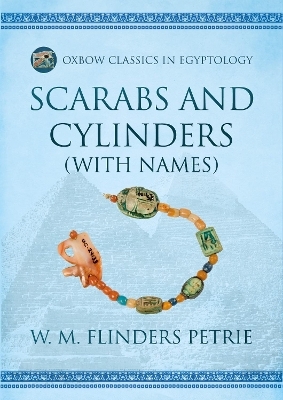
Scarabs and Cylinders (with Names)
Casemate Publishers (Verlag)
979-8-88857-002-9 (ISBN)
- Titel nicht im Sortiment
- Artikel merken
Facsimile edition of the 1974 reissue of Flinders Petrie’s 1917 pioneering typological catalogue of Egyptian name-scarabs and cylinders, one of a number of such catalogues to be reissued in this new series.
The beetle form of amulets are common finds on Egyptian sites but examples with engraved names represent a small proportion of the total. Over 240 different royal persons are named among the various major museum collections. Petrie here illustrates and discusses over 1,600 examples in his own collection together with a selection of inscribed steatite cylinders. He discusses the religious aspects of scarabs and their magical use, their varieties, materials and manufacture, and presents a chronological discussion with fully illustrated catalog of both line drawings and photographs.
This volume is part of a new series comprising facsimile re-issues of typological catalogues produced between 1898 and 1937 by W. M. Flinders Petrie, based on his vast collection of Egyptian artefacts. Mostly excavated by Petrie during many seasons of campaign in the latter years of the 19th and early decades of the 20th century, these artefacts now reside in the Petrie Museum at University College, London. Long out of print, the catalogues were re-issued in facsimile by publishers Aris & Phillips in the 1970s alongside newly-commissioned titles, based on more recent examination of elements of the Petrie Collection by contemporary experts. The Oxbow Classics in Egyptology series makes a selection of these important resources available again in print for a new generation of students and scholars.
Sir William Matthew Flinders Petrie (1853–1942) was a pioneer in the field of ‘modern’ archaeology. He introduced the stratigraphical approach in his Egyptian campaigns that underpins modern excavation techniques, explored scientific approaches to analysis and developed detailed typological studies of artefact classification and recording, which allowed for the stratigraphic dating of archaeological layers. He excavated and surveyed over 30 sites in Egypt, including Giza, Luxor, Amarna and Tell Nebesheh.
Introduction
1. Religious aspect of the scarab
2. The varieties of scarabs
3. The making of scarabs
4. The early cylinders, pls I–VII
5. The Old Kingdom, pls VIII–XI
6. The earliest age of scarabs
7. The Middle Kingdom
8. The New Kingdom
9. Ethiopians and Saites
Contents of plates, list of kings and census of scarabs
Summary of museums and dynasties
Index to text
Index of private names (lithographed)
Index of titles (lithographed)
I–LVIII. Plates of scarabs, and pages of catalogue
LIX–LXXIII. Plates of backs of scarabs
| Erscheinungsdatum | 12.05.2023 |
|---|---|
| Zusatzinfo | Fully illustrated with photographs and line drawings |
| Sprache | englisch |
| Maße | 210 x 296 mm |
| Themenwelt | Kunst / Musik / Theater |
| Geisteswissenschaften ► Archäologie | |
| Geschichte ► Allgemeine Geschichte ► Vor- und Frühgeschichte | |
| Geschichte ► Allgemeine Geschichte ► Altertum / Antike | |
| ISBN-13 | 979-8-88857-002-9 / 9798888570029 |
| Zustand | Neuware |
| Informationen gemäß Produktsicherheitsverordnung (GPSR) | |
| Haben Sie eine Frage zum Produkt? |
aus dem Bereich


